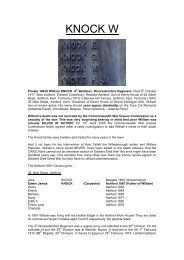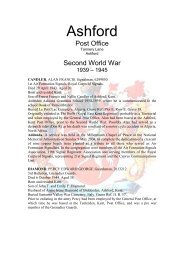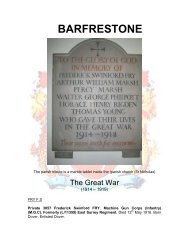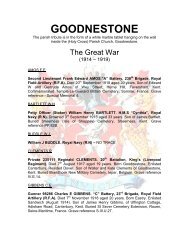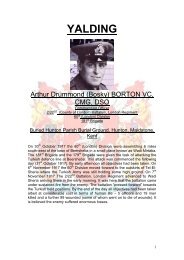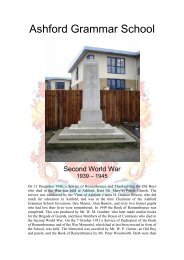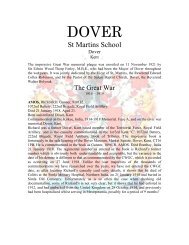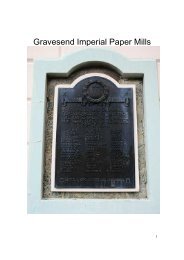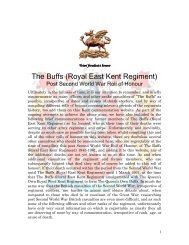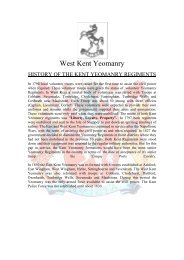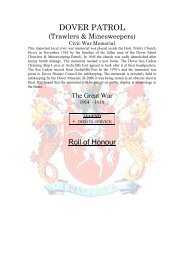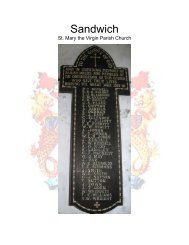HOLY TRINITY HALL MEMORIAL 1914-18 - Kent Fallen
HOLY TRINITY HALL MEMORIAL 1914-18 - Kent Fallen
HOLY TRINITY HALL MEMORIAL 1914-18 - Kent Fallen
You also want an ePaper? Increase the reach of your titles
YUMPU automatically turns print PDFs into web optimized ePapers that Google loves.
works in the<strong>18</strong>80’s, it being in stark contrast to the tranquil surroundings there today at<br />
Saphire Hoe. Shakespeare Colliery which was also known as Dover Colliery was <strong>Kent</strong>’s<br />
first coal colliery opening in <strong>18</strong>96 at the old Channel Tunnel workings, where prior to the<br />
tunnels abandonment coal had been discovered during the excavation process. After<br />
numerous setbacks the colliery was finally abandoned towards the end of the Great War<br />
and was it was in the hands of a Caretaker, who was Edward’s father, Charles Gatehouse.<br />
Several of the coal miners and others, chose to reside on the land surrounding the<br />
colliery, and all were of necessity notably hardy souls who were known by the townsfolk<br />
in times past as the ‘cliff dwellers,’ with the Gatehouse family being amongst their<br />
number. On the <strong>18</strong>81 census at which time Edward’s father a native of Dover, <strong>Kent</strong> was a<br />
Railway Labourer, the family residence was given as Folkestone Road Base, Shakespears<br />
Cliff, Hougham, Dover, <strong>Kent</strong>. The tunnel from the main road down to Saphire Hoe at the<br />
base of the cliffs was only made during the 1970’s Channel Tunnel workings, and during<br />
the ‘cliff dwellers’ times the only options was to climb the treacherous cliff path or go by<br />
sea. When Edward Gatehouse came home on sick leave, effectively to die and suffering<br />
like a vast number of Stokers from Tuberculosis, he came by sea. Following his death<br />
Edward’s body was taken from the Gatehouse family home for burial in Charlton<br />
Cemetery, Dover, by his father Charles who took it by sea. Despite or possibly due to, the<br />
harsh existence of ‘cliff dwelling’ several of the community lived to a quite a good age,<br />
in fact Charles Gatehouse, Edward’s father, died the day before his ninetieth birthday on<br />
30 September 1952. Edward’s mother, Elizabeth Mary Gatehouse died on <strong>18</strong> August<br />
1957 aged 94. The couple’s son Edward had enlisted in the Royal Navy in July 1906 and<br />
had initially served aboard H.M.S. “Acheron,” which was the former H.M.S.<br />
Northumberland, built in <strong>18</strong>68 as an armoured frigate she was renamed in 1904 and used<br />
as a Stoker’s training and depot ship at Chatham, <strong>Kent</strong>. Although Edward’s CWGC<br />
commemoration shows him as being a member of the ships company of H.M.S. Blonde,<br />
he had in fact due to his illness been posted for the last two months of his service to the<br />
Chatham Naval Barracks, H.M.S. Pembroke. Edward seems to have gone through<br />
something of a blip in his naval career over three consecutive years 1908, 1909 and 1910.<br />
On one occasion in 1908 Edward had “refused to carryout his duty,” and in 1909 and<br />
1910 had been placed in the cells!<br />
GRAVES, HENRY KNOTT. Acting Farrier Serjeant, 14546.<br />
88th Field Company, Royal Engineers.<br />
Died 13 October 19<strong>18</strong>.<br />
Born and enlisted Dover, <strong>Kent</strong>.<br />
Buried Basra War Cemetery, Iraq. Grave Ref: I. Q. 1.<br />
Formerly Driver and Acting Serjeant, 12th Field Company, Royal Engineers.<br />
GRIFFITHS, T. No clear trace.




